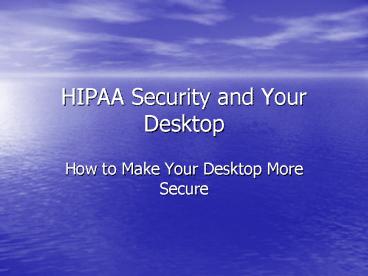HIPAA Security and Your Desktop PowerPoint PPT Presentation
1 / 16
Title: HIPAA Security and Your Desktop
1
HIPAA Security and Your Desktop
- How to Make Your Desktop More Secure
2
What does HIPAA mean?
- Health Insurance Portability and Accountability
Act - Why do we talk about it with regard to your
desktop?
3
Reasons to get started on HIPAA Security Measures
- Your Data is already at risk
- It's all about best practices that should already
be in place. - It's going to be cheaper and easier to do now
than in the future. - Current HIPAA privacy rule initiatives require
it. - Like privacy, the proposed security rule is more
about business culture and processes than it is
about technology, however there are still things
in technology that we can do to help keep things
private.
4
Technical Safeguards
- Control staff computer log-in and log-off.
- Monitor access of confidential information.
- Set up computers to authenticate users.
5
Things you can do to your desktop
- Change passwords often
- Automatic logoff After a pre-determined time of
inactivity (for example, 15 minutes), an
electronic session is terminated. - Privacy screens
- Update Software virus, malware, operating system
- User Account Types on Machine
6
Change Passwords
- UVM is working on a policy regarding passwords
and changing them. - So what can you do in the meantime?
- When selecting a password for anything always try
to mix alpha, numeric and special charaters. - Dont use common words
- Change Password every year
- Do not share passwords
- Do not save fixed passwords in your Web browser
or electronic mail client when using a computer
or system or accessing a resource - Do not store your passwords in a computer file
- Do not give out your password to someone over the
phone
7
Automatic Log Off
- Set computer to Automatically log off if some one
gets up and leaves the computer unattended. - Standard is 15mins however for laptops running on
battery standard is 5 mins. - Use Window key the letter L to lock your
screen when you get up to walk away from your
computer, and trains others in your department to
do the same.
8
Hardware Considerations
- Privacy Screens
- Critical depending on location of where key
people looking at sensitive data sit. (Example
front desk)
- Do not attached other equipment that can
compromise the network such as hubs, routers
without prior approval from CIT
9
Software, Virus Protection
- Update Software that has updates for critical
security issues. - Set Virus Protection to update automatically and
to scan C automatically
10
Malware
- What is malware? Hostile or Malicious Code
- This is code that mines for your data on your
computer. - Key Targets and Objectives of Malicious Code To
mine your data and sell it to the highest bidder
as well as other uses - Countermeasure Tools and Techniques Spybot
Adware
11
- Two types of Users on Machine
- Administrator Access to all files on computer,
can install programs and can change settings - Limited Account Runs installed software, but
cant install software, Can only change settings
for their own login. - Know what kind of users use your machine
12
Storing your Sensitive Date
- Thumb drives
- CDs
- File servers
13
Storage Devices
- Do not download confidential information to any
computer unless the person responsible for that
computer is an authorized information custodian
and the computer is University-owned.Computers
that contain confidential information should use
log-on passwords for access and should include
password-protected screen savers and/or locking
features, especially if the computer is located
in a cubicle or unlocked office. - Avoid printing confidential information. If you
need to do so, ensure that the paper copies of
the confidential information are adequately
protected (e.g., stored in a locked cabinet on
University property) and, when disposed of, are
shredded immediately.
14
- Do not send your or someone elses Social
Security number or other confidential information
over email or keep printouts of that information
in an insecure capacity such as on your desktop - Do not download or post confidential information
on any publicly accessible computer (e.g., those
in computer labs, cyber cafés, libraries,
residence halls), to mobile computing devices
(laptops, personal digital assistants, iPods,
etc.) and/or to non-University-owned computers.
15
- If you must download confidential information to
portable storage media (e.g., memory sticks, CDs,
diskettes), then ensure that the storage media
are secured in locked cabinets or desks on
University property and properly label the media. - Take special care in disposing of confidential
information when its storage is no longer
necessary, includingShredding paper copies of
any confidential information. - Erasing magnetic media (floppy disks, hard
drives, zip disks, etc.) with a degaussing device
or disk-wiping software. - Destroying CD ROM disks/shedders
16
Other Resources
- http//www.hipaadvisory.com/action/selfeval_afehct
.htm - http//www.mhanet.org/files/public/HIPAAsecurityru
le.pdf - http//edocket.access.gpo.gov/2003/pdf/03-3877.pdf

